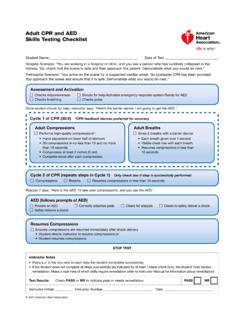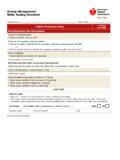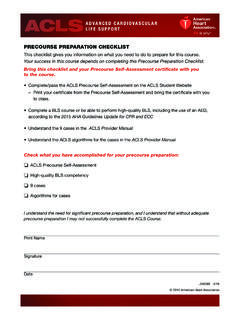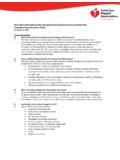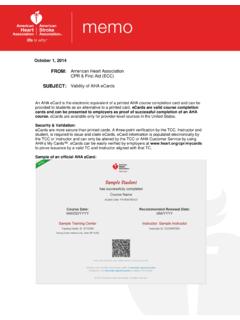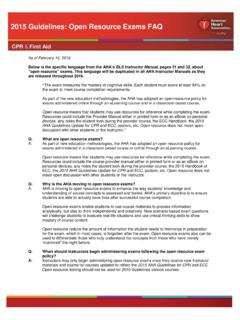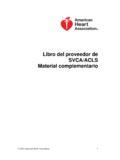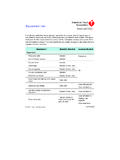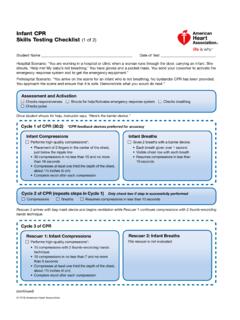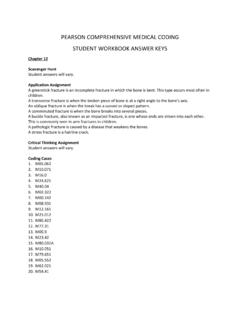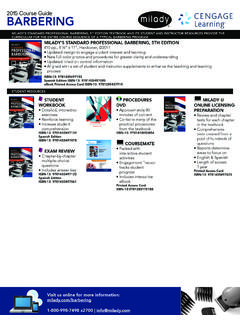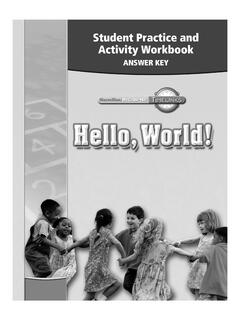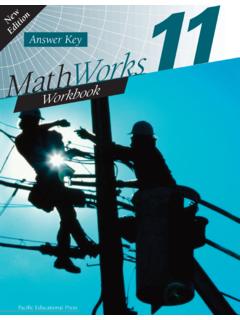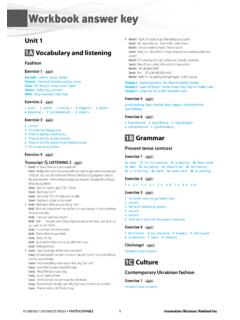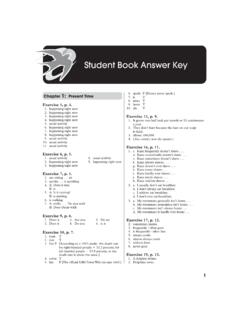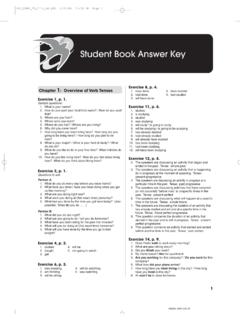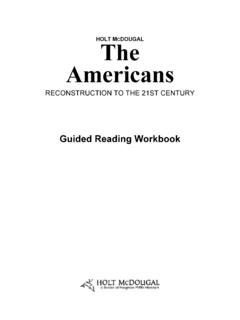Transcription of Answer Key to Review Questions in Student Workbook
1 Answer Key to Review Questions in Student Workbook Heartsaver Pediatric First Aid CPR AED 1 2016 American Heart Association First Aid Basics: Review Questions 1. What is the most important thing that you can do in an emergency? a. Don t do anything unless you are sure what to do b. Hope someone else comes who is better prepared c. Phone 9-1-1 d. Pretend you don t see the ill or injured child 2. Duties as a first aid rescuer include a. Maintaining the first aid kit b. Keeping private information about the ill or injured child private c. Understanding laws in your state that protect anyone who provides first aid d. All of the above 3. What is the most important step in preventing illness? a. Posting the poison control number near a phone b. Wearing a mask c. Putting all blood-containing material into a leak-proof bag d.
2 Handwashing 4. The purpose of taking your gloves off properly is to keep blood or fluids on the gloves from touching your skin. True False 5. Why is it important to Answer all of the dispatcher s Questions ? a. Because the 9-1-1 dispatcher needs to complete a survey b. Because it will get help to you as fast as possible c. To keep yourself safe so that you don t become injured too d. So the dispatcher can give a report to the media 6. When giving first aid to a child or infant, when should you phone 9-1-1? a. For every first aid emergency b. For a serious illness or injury c. If the child or infant has a fever and does not have a First Aid Action Plan d. Anytime bleeding is present 7. Which of the following may be true about how a child acts when something is wrong? a. The child may act ill or injured.
3 B. The child may act younger than she is. c. The child may need for you to talk to her based on her behavior, not her age. d. All of the above 8. If you are not sure what is wrong with a child, you ll need to find the problem. What is the first step you should take? a. Check for injuries or medical jewelry b. Check for breathing c. Make sure the scene is safe d. Check for a response (tap and shout) 2 Heartsaver Pediatric First Aid CPR AED 2016 American Heart Association Illnesses and Injuries: Group A Review Questions 1. What can stop most severe bleeding? a. Putting on gloves b. Putting direct pressure on the wound c. Applying an antibiotic cream d. Having the child lie down 2. Which of the following should be used as a dressing? a. A clean cloth b. A cold pack c. A dirty cloth d. A piece of tape 3.
4 Shock happens when a child has lost too much blood or water. True False 4. Which of the following is true of an epinephrine pen injection? a. It can be given through clothes or on bare skin. b. It should be used for every child with a rash. c. It can only be given through bare skin. d. It is always given in the side of the arm. 5. When a child has an asthma attack, what should you do? a. Give him something with sugar to drink. b. Leave him alone until his breathing gets better. c. Help the child use his prescription medicine. d. Give him thrusts above the belly button. 6. If a child with low blood sugar is able to sit up and swallow, give her something containing sugar to eat or drink. True False 7. Which of the following is true of heat stroke? a. Heat stroke can quickly turn into heat exhaustion.
5 B. Heat stroke is not dangerous. c. Heat stroke can be caused by exercising outside when the weather is very warm or hot. d. Heat stroke should be treated with warm water. 8. How can a child get hypothermia (low body temperature)? a. From walking in rain and wind without a jacket b. On a hot, sunny day c. When she doesn t have enough sugar in her blood d. After a seizure 9. In which of the following can a young child drown? a. A 5-gallon bucket b. A toilet c. A bathtub d. All of the above Heartsaver Pediatric First Aid CPR AED 3 2016 American Heart Association Illnesses and Injuries: Group B Review Questions 1. What should you do if a child has an injury that needs to be splinted? a. Place a plastic bag filled with warm water on the area to reduce swelling. b. Apply a splint only after an x-ray confirms that the bone is broken.
6 C. Ideally, place the splint so that it supports the joints above and below the injury. d. Straighten the injured body part before using a splint. 2. What should you do when a child gets a small burn? a. Cool the area with cold, but not ice-cold, water. b. Cover the area with lots of cold cream and butter. c. Put the child in a bathtub filled with ice. d. Run warm water on the burn until it doesn t hurt. 3. Which of the following is true of electrical injuries? a. Electrical injuries have no effect on the heart. b. Electrical injuries never cause injury inside the body. c. High-voltage electricity can travel through everything that touches the power line or source. d. All electrical injuries should be treated with ice. 4. What should you do if you suspect that a child has a fever? a. Allow the child to play with other children.
7 B. Check his temperature. c. Put ice packs on him. d. Cover him with a blanket. 5. What is the most important thing to do for a child with a suspected head, neck, or spinal injury? a. Have him sit up. b. Help him walk around. c. Do not twist or turn the head or neck. d. Give him a sports drink. 6. If a child has a penetrating injury, you should remove it as quickly as possible. True False 7. What should you do if a child has a seizure? a. Protect the child by moving furniture or other objects out of the way. b. Put a spoon in his mouth so he won t bite his tongue. c. Pin down his arms and legs so he will not injure them or scare other children. d. Turn the child over so he is facedown. 8. What should you do if a child has a permanent tooth knocked out? a. Always hold the tooth by the crown. b. Store the tooth in egg white, whole milk, or coconut water.
8 C. Immediately take the child and tooth to a dentist or emergency department. d. All of the above 9. What should a child with a nosebleed do? a. Lie flat on the ground, facedown b. Lean backward as you apply pressure on the soft part of the nose c. Blow his nose then hold an icepack on the back of his neck d. Lean forward as you apply pressure on the soft part of the nose 4 Heartsaver Pediatric First Aid CPR AED 2016 American Heart Association Preventing Illness and Injury: Review Questions 1. To help protect a child from burns, you should a. Keep hot appliances, like irons or curling irons, out of children s reach. b. Keep children away from hot liquids, such as a cup of coffee. c. Cook on the back burners, and keep children away from the stove. d. All of the above 2. Which of the following reduces the risk of SIDS?
9 A. Putting the infant to sleep on her back b. Putting the infant to sleep on her stomach c. Ensuring the infant has a First Aid Action Plan d. Ensuring that the infant s car seat is installed correctly 3. A correctly installed car seat will not shift more than _____ side to side or back to front. a. 1 inch b. inches c. 2 inches d. inches 4. In a poisoning emergency, whom should you call first? a. An urgent care center b. The poison control center c. 9-1-1 d. The child s parent or caregiver 5. Before a child starts playing an organized sport, the parent or caregiver should a. Have his abilities accessed to see if he will be good at the sport b. Do nothing just show up on the first day, ready to play c. Check with the child s healthcare provider to identify any illness or injury that might put the child at risk d.
10 Wait until the child has played the sport for several weeks to see if any problems develop 6. If a child has a known allergy to bee stings, you should a. Not allow the child to participate in outdoor activities b. Make sure that the child s epinephrine pen is available at all times c. Keep the child inside except during the winter d. Call the parent or caregiver if the child gets stung before you do anything else 7. Which of the following can cause a poisoning emergency? a. A button battery b. A dishwasher tablet c. Blood pressure pills from grandmother s purse d. All of the above
